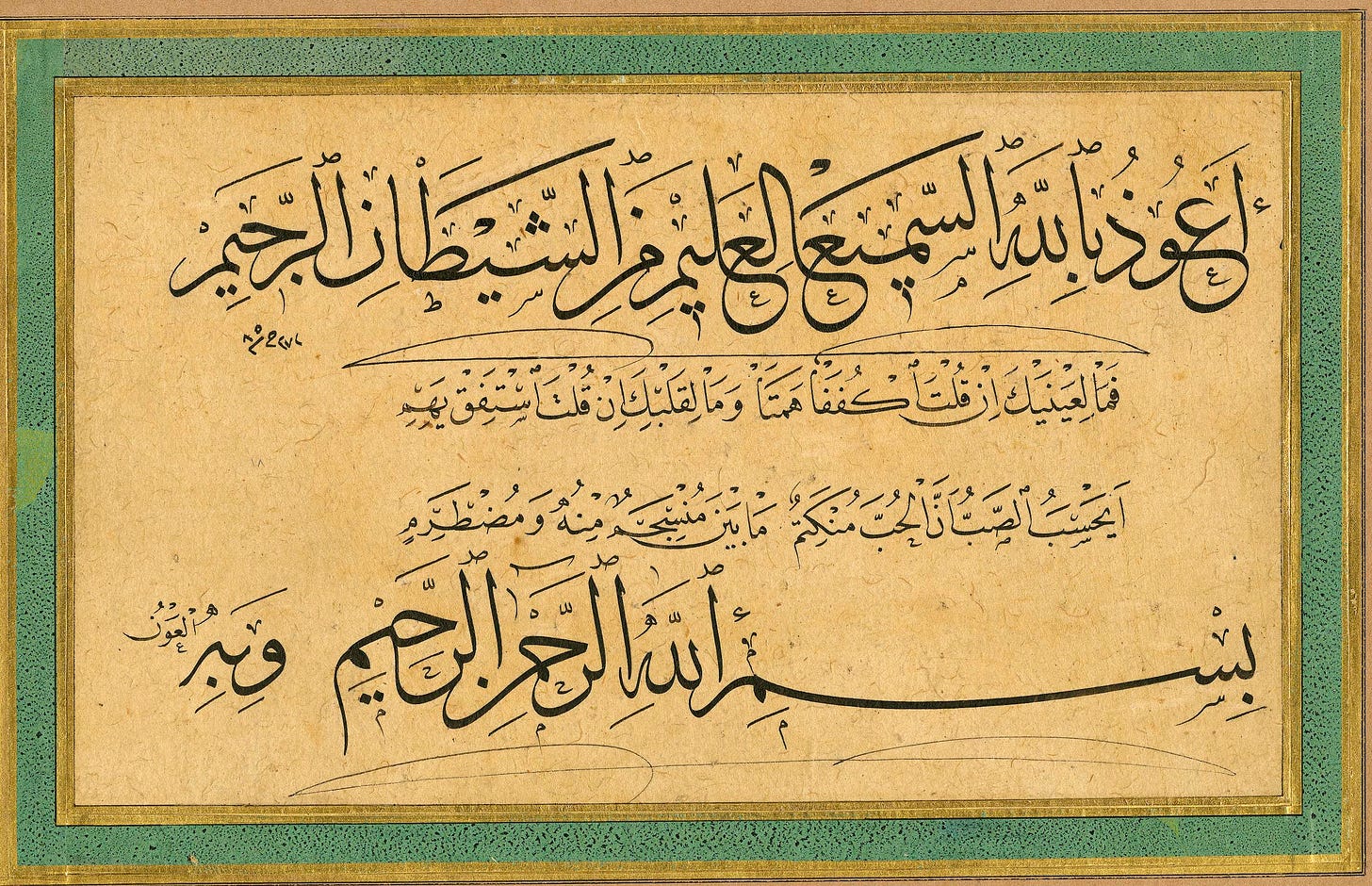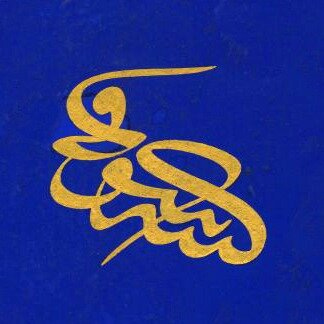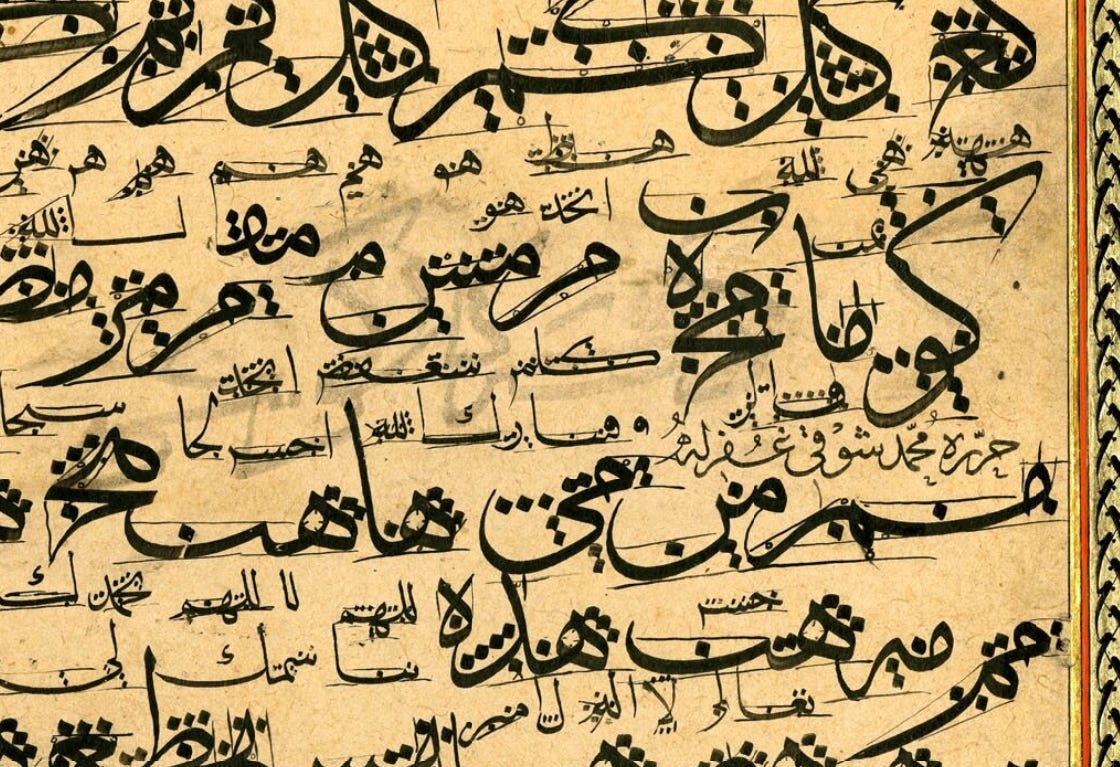Portrait: Mehmed Şevki Efendi
Mastering the Pen: Insights on the life of one of the greatest calligraphers in history.
Introduction
Mehmed Şevki (Shawqi) Efendi was born in Seyyidler district in Kastamonu in 1829 (hijri 1245). His father, Ahmed Ağa, was a merchant there. At the age of three, Mehmed Şevki Efendi's parents passed away, and he was brought to Istanbul by his uncle, Seyyid Mehmed Hulûsi Efendi. He completed his primary education at the Maktab Al-Sibyan in Aksaray, Yusufpaşa. His uncle, who was the head librarian of the Râgıb Paşa Library, taught him the introductory sciences. He also learned calligraphy from him and received his ijazah (certificate) in the six major scripts at the age of 12.
Mehmed Şevki Efendi's devotion to his craft extended beyond his own artistic pursuits. He dedicated himself to the preservation and dissemination of calligraphy. He meticulously studied the works of renowned calligraphers such as Hâfız Osman and İsmail Zühdi, drawing inspiration from their works. His deep understanding and unwavering determination allowed him to grasp calligraphy's secrets fully.
Sevki Efendi's Unique Style
Mehmed Şevki Efendi continuously progressed and refined his skills throughout his journey. He is notably recognized for his delicate and refined style, which reached its pinnacle around 1873. His unique calligraphic works continue to be admired and appreciated to this day.

Despite finding his own style, Mehmed Şevki Efendi remained humble and sought guidance from his teacher, Hulûsi Efendi. He often visited his teacher and patiently waited for his turn among other students. This dedication and commitment to learning exemplified his passion for calligraphy.
When Hulûsi Efendi gave ijazah to Şevki Efendi at the age of twelve, he said:
"My son! Now you have surpassed me in every aspect, so it would be better if you showed what you wrote to Kazasker Mustafa İzzet Efendi, one of the distinguished people of our time, for consultation from time to time and be inspired by his fine artistic feelings in this field.”
However, Şevki Efendi showed a great example of loyalty and respect by saying: “My teacher and my dear uncle, You are more than enough for me. I will not leave you, and I cannot return to anyone else but you."
The teacher immediately started to cry with joy at this situation and prayed for blessings with the words, "May everyone stand in pure honour for you and your works until the day of judgment."
Mehmed Şevki Efendi's talent and dedication earned him a well-deserved reputation. He was known for his impeccable and lively works, which garnered him significant recognition. His close friend, Sâmi Efendi, once remarked that even if he asked Mehmed Şevki Efendi to write poorly, he could not produce a mediocre work. This statement reflects the undeniable truth of his exceptional skills.

Mehmed Şevki Efendi was known for his exceptional skills in Thuluth and Naskh scripts, making him stand out among other calligraphers of his time. In Thuluth script, he established a style that was reminiscent of the renowned calligrapher Hafiz Osman. His Thuluth works were characterized by delicate and refined strokes, showcasing his mastery over the script.
In Naskh script, Mehmed Şevki Efendi demonstrated perfection and excellence. His meticulous and disciplined approach to writing allowed him to create flawless and stylish Naskh compositions. He paid great attention to detail and precision, ensuring that his works in Naskh script were of the highest quality.

His unique style in both Thuluth and Naskh scripts earned him a rightful reputation among Turkish calligraphers. His works in these scripts can be found in various collections, museums, and private collections, reflecting his mastery and artistic excellence in both styles.
Legacy & Influence
Throughout his life, Mehmed Şevki Efendi trained numerous students, including Filibeli Hacı Şerif, Hafız Fehmi, Pazarcıklı Mehmed Hulûsi, Ziyâeddin Efendi, and Ferid Bey. He shared his knowledge and expertise, nurturing a new generation of calligraphers who would carry on his legacy.
He attributed his success to divine guidance, stating that calligraphy was taught to him in a dream. This acknowledgement of his achievements as a gift from Allah further emphasized his humility and gratitude.
With the accession of Abdulhamid II, Şevki Efendi was entrusted with teaching calligraphy at the newly established Mekteb-i Şehzadegân, located within the confines of the Yıldız Palace. This appointment cemented his position as a prominent figure in the calligraphic community. His exceptional talent did not go unnoticed by the Sultan, who often sought his expertise and granted him various honours, including the Majîdî medal of the third rank in 1883.
In his personal life, Mehmed Şevki Efendi was known for his modesty and integrity. He lived a simple life, dedicating his income solely to his basic needs and distributing the rest to the needy in Kastamonu and Istanbul. Even after his passing, it was discovered that he had been supporting thirty poor individuals on a monthly basis.
Later Life & Works
Mehmed Şevki Efendi passed away on May 8, 1887 (14 Sha'ban 1304 H) after performing his pilgrimage. He was buried next to his uncle & master, Hulusi Efendi, at the Merkez Efendi Cemetery in Istanbul. His son and student Mehmed Said Bey wrote the inscription on his gravestone.
Mehmed Şevki Efendi's contributions to calligraphy were not limited to his own works. He also played a significant role in the production of important calligraphic manuscripts. He was mainly devoted to writing the hilye, a description of the Prophet Muhammad, which he considered a special honour.
Mehmed Şevki Efendi left behind a rich collection of calligraphic works, including mushafs (Qur'ans), Delâilü'l-Hayrât, hilyas, lawhas, kıtas, and murakkas. His masterpieces can be found in various collections and museums, showcasing his exceptional talent and serving as a testament to his artistic legacy.
In conclusion, Mehmed Şevki Efendi was a highly esteemed calligrapher who made significant contributions to the art of calligraphy. His mastery of various calligraphic styles, his humility, and his dedication to preserving and sharing his knowledge have left an indelible mark on the world of calligraphy. His works continue to inspire and captivate audiences, ensuring that his legacy lives on.







